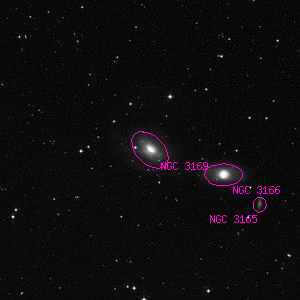NGC 3169

Overlaid DSS image of NGC 3169, 30' x 30' with north at top and west to the right
Aladin viewer for the region around NGC 3169
H I 4, h 685, GC 2041, MCG+01-26-026, UGC 5525, PGC 29855, SDSS J101415.04+032758.0
| Type | Galaxy |
|---|---|
| Magnitude | 12.41 |
| Size | 4.47' x 2.69' @ 45° |
| Right Ascension | 10h 14' 15.1" (2000) |
| Declination | 3° 27' 58" N |
| Constellation | Sextans |
| Description | B, pL, vlE, pgmbM, *11, 78, 80", 3rd of 3 |
| Classification | Sa |
Observing Notes
Andrew Cooper
Apr 29, 2006 TIMPA, Avra Valley, AZ (map)
46cm f/4.5 Deep Violet
Good sized, bright, modest stellar nucleus in a featureless even halo with no detail, NGC3166 is visible 15' SW, a little bigger and brighter than NGC3169, very nice pair!
Rev. T.W. Webb
May 19, 1885 Hardwick, Herefordshire, England (map)
Two very faint nebulæ [with NGC3166] in a glorious field. H. missed the fainter though he observed the other 4 times. D'A saw 3 [NGC3165?], and called H. I 3 admodum luminosa [NGC3166]. Such was the working of the Copenhagen 11-in. achr.― Celestial Objects for Common Telescopes, T. W. Webb, 1917
Captain William Henry Smyth
Jan 8, 1837 No. 6 The Crescent, Bedford, England (map)
150mm f/17.6 refractor by Tully 1827
A bright-class round nebula, on the frame of the instrument, with another, rather larger but more faint, at about 29s on the following parallel; the latter being attended by three stars, the middle one of which is the smallest, and is closely nf. This was discovered by William Herschel in December, 1783, but it is very remarkable, that, though he made four observations of the object, he did not notice that there were two nebulae in the field. John Herschel, however, saw them both, and has described them under No. 685. The place is not very difficult to find, being about 9° south by east of Regulus, and in the line with that luminary and μ in the head of the Lion.
This object is on or near the spot where the Capuchin, De Rheita, fancied he saw the napkin of S. Veronica, in 1643, with an improved telescope which he had just constructed. It would be much easier to ascribe this strange discovery to a heated imagination, than to deliberate falsehood; but it happens unfortunately that there is no staring cluster or nebula near. However, in case any one still chooses to search for it, we may state, that in a letter to his friend J. Caramuelis, dated Cologne, 24th April, 1643, he mentions having detected most clearly, by means of his binocular telescope, with the greatest surprise, admiration, and delight, the sacred " sudarium Veronicas sive faciem Domini maxima similitudine in astris expressum," in the sign of Leo, between the equinoctial and the zodiacal circles. And this is an accurate reduction of the figure which Zahn gives of it in the Oculus Artificialis*
Padre de Rheita makes very respectable mention of this same apparition in his great work, Oculus Enoch et Elice, sive Radius Sidereo- mysticus, the very elaborate engraved title-page of which thus invites us, in the words of the Royal Psalmist, Venite et vldete opera Domini. In craving permission to doubt his assertion, Sir John Herschel's words may be applied: "Many strange things were seen among the stars before the use of powerful telescopes became common."― A Cycle of Celestial Objects Vol II, The Bedford Catalogue, William Henry Smyth, 1844
Other Data Sources for NGC 3169
Nearby objects for NGC 3169
Credits...
Drawings, descriptions, and CCD photos are copyright Andrew Cooper unless otherwise noted, no usage without permission.
A complete list of credits and sources can be found on the about page
NGC 3169